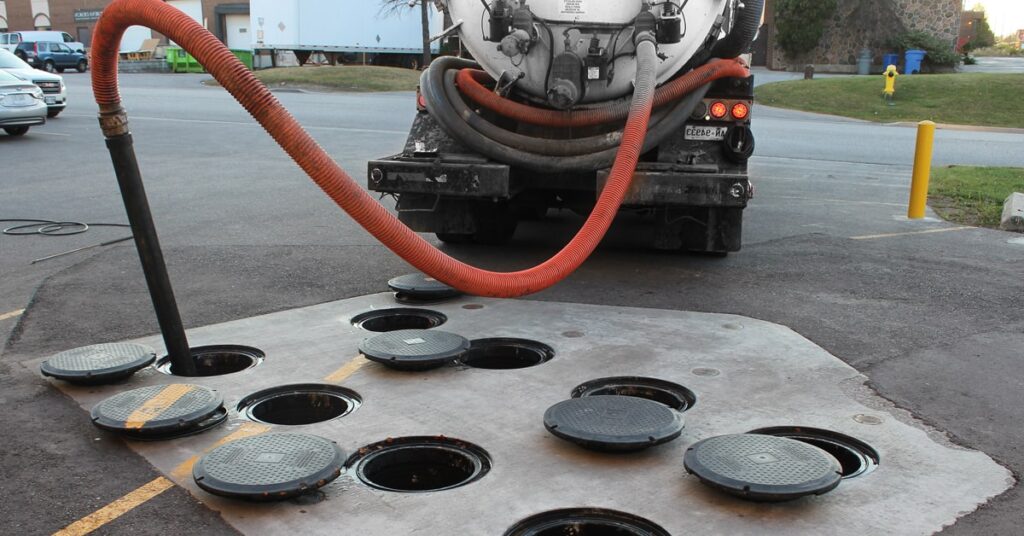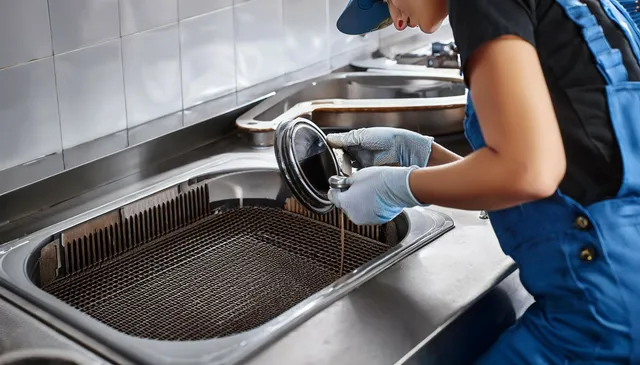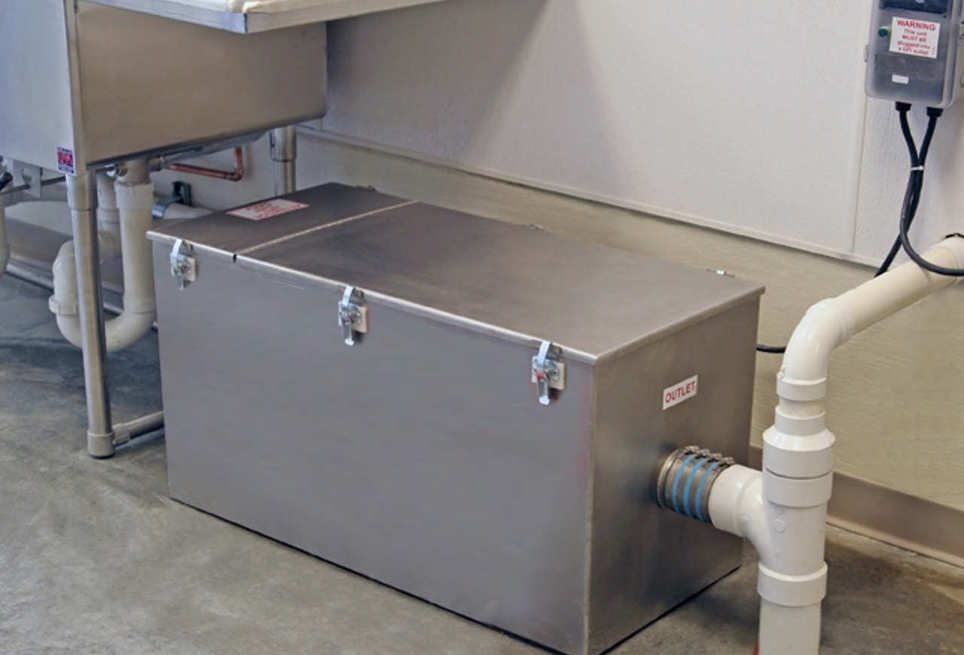How to Calculate Grease Trap Size – Fast & Accurate Method
Choosing the right size grease trap is crucial for keeping your plumbing running smoothly and meeting local regulations.
A well-sized grease trap prevents fats, oils, and grease from clogging pipes and causing damage.
In this guide, we’ll walk you through how to calculate the perfect size for your grease trap, tailored to your kitchen’s needs and the type of establishment you operate.
How to calculate grease trap size?
To calculate grease trap size, consider the number of fixtures, type of establishment, and waste volume. A licensed plumber or local authority can help determine the right size for your needs.
Key Takeaways
- The size of a grease trap is determined by the amount of wastewater generated and the size of your establishment.
- Calculating the correct size ensures proper waste management and prevents issues like grease buildup and blockages.
- Factors like kitchen equipment, peak flow times, and local regulations should be considered when sizing your grease trap.
What Is a Grease Trap and Why Is It Important?

A grease trap is an essential device used in plumbing systems to separate and trap grease, oils, and other solids before they enter the wastewater system.
This crucial appliance works by slowing down the flow of wastewater, allowing grease, oils, and fats to solidify and float to the top, where they can be easily removed.
It’s a vital component in many commercial kitchens, especially in restaurants, hotels, cafeterias, and food processing facilities, where grease and fat are commonly used in food preparation.
Without a functioning grease trap, fats, oils, and grease (FOG) can easily clog the pipes, leading to costly plumbing issues, unpleasant odours, and potential environmental contamination.
Grease traps are designed to capture and prevent FOG from entering the municipal sewer system, which is why they are particularly important in the foodservice industry.
In a commercial kitchen, large quantities of grease are produced during cooking and washing, and if not properly managed, these substances can cause significant blockages in the plumbing system.
A grease trap works by allowing wastewater to enter the device, where it slows down, giving the grease and solids time to separate from the water.
The grease then rises to the top, while the clearer water flows out and continues to the drain.
The trapped grease is periodically removed by cleaning the trap, ensuring that it doesn’t accumulate and cause clogs.
The importance of a properly maintained grease trap cannot be overstated. If grease and other solids are allowed to pass into the wastewater system, they can lead to a variety of problems.
Over time, the accumulated grease can build up in pipes, leading to blockages that can be difficult and expensive to clear.
These blockages can result in sewage backups, which may cause unsanitary conditions in the kitchen and could potentially shut down operations until the issue is resolved.
Furthermore, the accumulation of grease in the sewer system can also contribute to environmental problems, including the contamination of water sources, which is why local governments have strict regulations regarding the proper disposal of grease.
In addition to the risk of plumbing issues, not having a properly sized or functioning grease trap can also lead to odours in the kitchen and surrounding areas.
As grease sits in the pipes or the grease trap itself, it can begin to decompose, causing unpleasant smells that can affect the overall atmosphere of the establishment.
These smells not only make the kitchen environment less pleasant but can also affect the quality of food and the overall dining experience for customers.
Another important aspect of grease traps is their role in ensuring compliance with local water treatment regulations.
Most municipalities and environmental agencies require commercial kitchens to have grease traps installed to reduce the amount of grease entering the public sewer system.
Failure to comply with these regulations can result in fines and penalties for non-compliance, which could significantly impact the profitability and reputation of the business.
Ensuring that the grease trap is the correct size and properly maintained helps businesses avoid these penalties and maintain a good standing with local authorities.
The size of the grease trap is crucial to its effectiveness.
A grease trap that is too small for the volume of wastewater generated by the kitchen will not be able to effectively capture all the grease, leading to problems with clogging and odours.
On the other hand, an oversized grease trap can be wasteful, taking up unnecessary space and requiring more maintenance than is necessary.
It’s important to choose a grease trap that is appropriately sized for the needs of the kitchen, taking into account factors like the size of the kitchen, the amount of food prepared, and the volume of water used.
Grease trap maintenance is also key to ensuring its continued effectiveness. Regular cleaning is required to remove the accumulated grease and solids from the trap.
The frequency of cleaning depends on the size of the trap and the amount of grease generated, but typically, grease traps should be cleaned every 1 to 3 months.
If the trap is not cleaned regularly, the buildup of grease can cause it to overflow, leading to potential plumbing issues and health concerns.
Professional grease trap cleaning services can help ensure that the trap is properly maintained and that the kitchen’s plumbing system remains in good working order.
In conclusion, a grease trap is an essential device for any commercial kitchen, helping to prevent clogs, reduce odours, and ensure compliance with environmental regulations.
Proper installation, sizing, and maintenance of the grease trap are crucial for the smooth operation of the kitchen and to avoid costly plumbing repairs.
Regular cleaning and inspections will ensure that the system continues to function effectively, helping to maintain a safe, sanitary, and efficient kitchen environment.
Factors to Consider When Calculating Grease Trap Size

Several factors come into play when determining the right size for your grease trap.
While every establishment will have its own unique needs, there are some general guidelines you can follow to make the right choice.
1. Wastewater Flow Rate
The wastewater flow rate is one of the key factors in sizing a grease trap. This refers to the amount of wastewater that enters the trap per minute.
In commercial kitchens, wastewater typically comes from sinks, dishwashers, and other food preparation equipment.
To calculate the flow rate, determine the average water usage in your kitchen. This is usually measured in gallons per minute (GPM).
How to Calculate: Add up the flow rates of all the fixtures that discharge into the grease trap.
For example, if your kitchen has a sink with a flow rate of 2 GPM and a dishwasher with a flow rate of 3 GPM, your total wastewater flow rate would be 5 GPM.
2. Size and Type of Kitchen Equipment
The type and number of kitchen appliances you use will also affect the size of the grease trap needed.
Larger kitchens with multiple cooking stations or heavy-use equipment like deep fryers, grills, and dishwashers will generate more grease, requiring a larger trap.
How to Calculate: For each piece of equipment, check the manufacturer’s specifications for its wastewater flow rate.
Sum up the total flow rate to get an estimate of how much water needs to be processed by the grease trap.
3. Peak Flow Times
Peak flow times refer to the hours when the kitchen is operating at full capacity, such as during lunch or dinner service.
During these times, the amount of wastewater generated will be higher than during off-peak hours. It’s essential to ensure that your grease trap can handle this surge in wastewater.
How to Calculate: Estimate the peak flow rate based on your busiest hours. Multiply the regular flow rate by a factor (usually between 1.5 and 2) to account for peak usage.
4. Local Regulations
Different localities have different rules and regulations regarding grease trap sizing.
Some areas may have specific requirements based on the size of your establishment, the type of business, or the volume of wastewater you generate.
How to Calculate: Check with your local water authority or health department to see if there are specific guidelines you need to follow.
They may provide a formula or sizing chart based on your kitchen’s square footage and number of employees.
How to Calculate the Size of a Grease Trap

Now that we’ve covered the factors to consider, here’s a step-by-step process for calculating the size of your grease trap.
Step 1: Calculate the Wastewater Flow Rate
As mentioned earlier, you’ll need to calculate the wastewater flow rate in gallons per minute (GPM).
This is typically based on the number of sinks, dishwashers, and other appliances in your kitchen.
Example: If you have 3 sinks (2 GPM each) and 1 dishwasher (5 GPM), your total flow rate would be:
- 3 sinks x 2 GPM = 6 GPM
- 1 dishwasher x 5 GPM = 5 GPM
- Total flow rate = 6 GPM + 5 GPM = 11 GPM
Step 2: Determine the Grease Trap Capacity
The grease trap size is usually specified in gallons and typically varies depending on the flow rate.
You will need to use the flow rate calculation to determine the minimum size required for your kitchen.
For example, for every 10 GPM, a grease trap should generally have a capacity of at least 30 to 40 gallons.
Therefore, if your total flow rate is 11 GPM, you would likely need a grease trap with a capacity of around 40 to 45 gallons.
Step 3: Consider Peak Flow Rate Adjustments
During peak flow times, you need to account for a higher volume of wastewater.
To adjust for this, multiply the regular flow rate by a factor of 1.5 to 2, depending on the size and usage of your kitchen.
Example: If your kitchen experiences peak times of 1.5 times the usual flow rate, your adjusted flow rate would be:
- 11 GPM x 1.5 = 16.5 GPM
- Therefore, you would need a grease trap with a capacity of at least 50 to 65 gallons.
Step 4: Check Local Regulations
Ensure that the size of the grease trap meets local regulations.
Some areas may have stricter requirements for grease trap sizing, especially in larger restaurants or foodservice establishments.
Consult with local authorities to make sure you are compliant.
Types of Grease Traps

There are different types of grease traps, each with its own advantages. Understanding the options available can help you choose the best fit for your business.
1. Under-Sink Grease Traps
These are compact units that are installed directly under sinks. They are suitable for smaller kitchens and commercial settings with limited space.
However, they may not be sufficient for larger operations with high volumes of wastewater.
2. External Grease Traps
These are larger, outdoor units designed for high-volume kitchens. They can handle larger flow rates and are more commonly used in large restaurants and commercial establishments.
These traps are usually installed outside the building, making them ideal for larger operations.
3. Automatic Grease Removal Units (AGRUs)
These high-tech units automatically remove grease from the trap, reducing the need for manual cleaning.
AGRUs are often used in larger operations where ease of maintenance and higher capacity are required.
Maintenance of Your Grease Trap
Proper maintenance is key to ensuring your grease trap functions effectively and prevents blockages. Some important maintenance tips include:
Regular Cleaning: Clean your grease trap every 1 to 3 months, depending on usage. If your kitchen generates a lot of grease, more frequent cleaning may be necessary.
Check for Clogs: Always check the grease trap for clogs or blockages. Over time, grease can harden and block the drain lines, leading to backups and costly repairs.
Monitor the Trap’s Capacity: If you notice that your grease trap is filling up too quickly, it may be a sign that it’s too small for your kitchen’s needs. Consider upgrading to a larger model.
Frequently Asked Questions
1. How often should I clean my grease trap?
Grease traps should typically be cleaned every 1 to 3 months, depending on the size of your kitchen and the volume of waste produced. High-volume kitchens may require more frequent cleaning.
2. Can I install a grease trap myself?
It is possible to install a grease trap yourself if you have plumbing experience, but it’s often best to hire a professional to ensure it is installed correctly and complies with local regulations.
3. What happens if I don’t maintain my grease trap?
Failing to maintain your grease trap can lead to clogged drains, bad odours, and potential fines for non-compliance. Regular maintenance ensures your system works efficiently and prevents costly repairs.
Conclusion
Calculating the proper size for your grease trap is essential to ensure efficient operation and prevent plumbing issues in your commercial kitchen.
By considering factors such as wastewater flow, kitchen equipment, peak flow times, and local regulations, you can select the right size grease trap for your needs.
Regular maintenance is just as important to keep the system functioning properly, so be sure to clean and inspect your grease trap as recommended.
With the right grease trap, you can maintain a smooth-running kitchen, avoid environmental damage, and stay compliant with local regulations.
